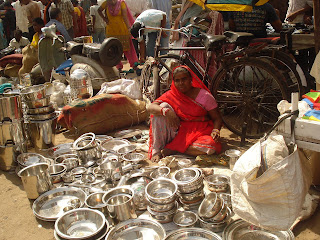
The Teen Darwaza market is surrounded by residential area, which falls just adjoining to the zone of government institutions. Besides, there are also some public buildings like Premabhai Hall, Bhadrakali Temple nearby. This type of mixed landuse around the market makes the function of market as a neighborhood level market. It sells almost everything ranging from fish, meat, and vegetables to articles of daily use, footwear, bags, toys etc. there are around 3000 street vendors in this market and around 15,000-20,000 customers visit Teen Darwaza everyday. It is interesting to know that informal market in this area serves much more customers than the formal shops in the same area. People believe that the street vendors give a much better bargain there than the shops.
Unbelievably, the street vendors on both sides of the road and the parking together have reduced the road width to one-third, but still this old settlement is not questioned much, because of the service it offers.






















